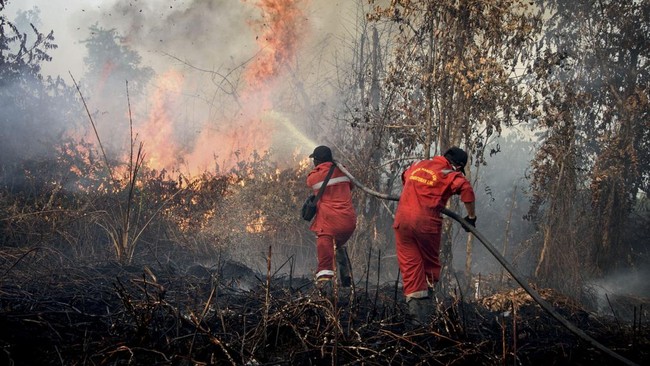
Forest and land fires in Rokan Hilir Regency, Riau Province, are suspected to have been deliberately set. Entering the peak of the dry season and facing severe drought, the region has become increasingly vulnerable to fires, which also risk spreading.
The fires have lasted for ten days and are believed to have been primarily caused by human activity. According to the Pekanbaru Meteorology, Climatology, and Geophysics Agency (BMKG), satellite monitoring from Terra Aqua detected 186 hotspots across Riau.
Professor Priyono Suryanto from the Faculty of Forestry at Universitas Gadjah Mada observed that many forest fires are a common method of land clearing for oil palm plantations, indicating the presence of a complex network of actors behind haze-related crimes.
“There is a strong interconnection between land clearing and the increasing risk of forest and land fires,” he said on Thursday (Aug. 14).
Professor Suryanto explained that Indonesia has long had ancestral references related to the culture of fire, particularly through the rotational farming system (sistem perladangan berputar/SPB).
In its initial stage, SPB involved slash-and-burn practices, where fire was regarded as sacred, serving to build a civilization that reproduced forest ecosystems. In its final stage, SPB restored the forest ecosystem in the form of agroforestry, resembling natural forests.
Over time, however, the meaning of fire has diminished or become distorted.
“The mandate of fire has been reduced to simply burning for easy, cheap, large-scale, and profitable land clearing, while concealing accountability. The traces of burning quickly disappear, are difficult to prove, and are often attributed only to individuals at the fire site, not the wider network of actors,” Professor Suryanto explained.
He further noted that the concept of mitigating forest and land fires has been well-established, though its implementation varies. He acknowledged that Indonesia’s legal approach is commendable, but it also leaves room for innovative methods of exploitation in the field.
“The root causes, solutions, and mitigation efforts for forest fires and haze disasters have always been identified, yet these phenomena persist alongside us,” he said.
Professor Suryanto emphasized that Indonesians must revisit their history and cultural values to rediscover the sacred meaning of fire as a noble cultural heritage of the archipelago, one that plays an essential role in regenerating forest ecosystems.
“When we view fire as part of Nusantara culture, fire becomes a spirit, a path of enlightenment, a solution, and a form of indigenous mitigation,” said the Chair of the Indonesian Agroforestry Society (MAFI).
As Indonesia approaches its 80th Independence Day celebration, Professor Suryanto urged the nation to engage in national reflection by preserving ancestral heritage and revisiting indigenous prescribed burning as a powerful literacy tool for mitigating forest fires while supporting forest ecosystem regeneration.
This, he stressed, should be accompanied by holistic studies and synergy with other government programs, such as transmigration, social forestry, and customary forest management, all of which should be strongly linked to economic independence.
“The key is to fully mobilize communities with noble values and mutual cooperation, ensuring that society stands strong on its pillars of life, not easily swayed by short-term promises of profit that bring long-term harm,” he concluded.
Author: Alena
Editor: Gusti Grehenson
Photograph: AFP

